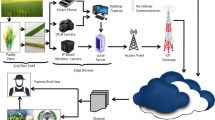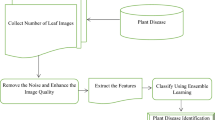Abstract
The present work focuses on detecting disease in big fields of bell peppers using a hybrid feature fusion and machine learning approach. For the most part, farmers of bell peppers don’t know if their plants are contaminated with bacterial spot disease until it's too late. Reduced harvests are a common result of the spread of the disease. The key idea is to determine early on if the bell pepper plant is infected with bacterial spot disease. For classification random forest (RF) is used. The proposed method is divided into three stages namely-image pre-processing, feature extraction and classification. For feature extraction, we considered three features such as local binary pattern (LBP) features, visual geometry group network (VGG-16) features and fused LBP & VGG-16 features. The classification accuracy obtained by the proposed model is compared with classification accuracy obtained by some researchers in their articles. The accuracy obtained with RF classifier for pepper bell dataset with LBP feature, VGG-16 feature and LBP + VGG-16 fused feature are 78.11%, 92.28% and 99.75% respectively. With the help of the proposed model, farmers can quickly detect the onset of plant diseases and take preventative measures to limit their impact. The goal of this work is to devise a means of diagnosing bacterial spot disease in bell pepper plants using only images captured in the farm.







Similar content being viewed by others
Explore related subjects
Discover the latest articles, news and stories from top researchers in related subjects.References
Jackson RD et al (1986) Detection and evaluation of plant stresses for crop management decisions. IEEE Trans Geosci Remote Sens 1:99–106
Schor N et al (2016) Robotic disease detection in greenhouses: combined detection of powdery mildew and tomato spotted wilt virus. IEEE Robot Autom Lett 1(1):354–360
Bhagat M, Kumar D, Kumar D (2019) Role of internet of things (IoT) in smart farming: a brief survey. In: 2019 devices for integrated circuit (DevIC), Kalyani, India, pp 141–145. https://doi.org/10.1109/DEVIC.2019.8783800
Nerkar B, Talbar S (2021) Cross-dataset learning for performance improvement of leaf disease detection using reinforced generative adversarial networks. Int J Inf Technol 13:2305–2312. https://doi.org/10.1007/s41870-021-00772-1
Upadhyay SK, Kumar A (2022) A novel approach for rice plant diseases classification with deep convolutional neural network. Int J Inf Technol 14:185–199. https://doi.org/10.1007/s41870-021-00817-5
Singh K, Kumar S, Kaur P (2019) Support vector machine classifier based detection of fungal rust disease in Pea Plant (Pisam sativam). Int J Inf Technol 11:485–492. https://doi.org/10.1007/s41870-018-0134-z
Jana S, Begum AR, Selvaganesan S (2020) Design and analysis of pepper leaf disease detection using deep belief network. Eur J Mol Clin Med 7(9):1724–1731
Bhagat M, Kumar D, Haque I, Munda HS, Bhagat R (2020) Plant leaf disease classification using grid search based SVM. In: 2nd international conference on data, engineering and applications (IDEA), Bhopal, India, pp 1–6. https://doi.org/10.1109/IDEA49133.2020.9170725
Bhagat M, Kumar D, Mahmood R, Pati B, Kumar M (2020) Bell pepper leaf disease classification using CNN. In: 2nd international conference on data, engineering and applications (IDEA), Bhopal, India, pp 1–5. https://doi.org/10.1109/IDEA49133.2020.9170728
Ramesh S, Vydeki D (2020) Recognition and classification of paddy leaf diseases using optimized deep neural network with Jaya algorithm. Inf Process Agric 7(2):249–260
Zeng Y et al (2021) Pepper disease detection model based on convolutional neural network and transfer learning. IOP conference series: earth and environmental science, vol 792(1). IOP Publishing
Ngugi LC, Abelwahab M, Abo-Zahhad M (2021) Recent advances in image processing techniques for automated leaf pest and disease recognition—a review. Inf Process Agric 8(1):27–51
Sambasivam G, Geoffrey DO (2021) A predictive machine learning application in agriculture: Cassava disease detection and classification with imbalanced dataset using convolutional neural networks. Egypt Inf J 22(1):27–34
Chowdhury MEH et al (2021) Automatic and reliable leaf disease detection using deep learning techniques. AgriEngineering 3(2):294–312
Hassan SM, Maji AK, Jasiński M, Leonowicz Z, Jasińska E (2021) Identification of plant-leaf diseases using CNN and transfer-learning approach. Electronics 10:1388. https://doi.org/10.3390/electronics10121388
Jadhav SB, Udupi VR, Patil SB (2021) Identification of plant diseases using convolutional neural networks. Int J Inf Technol 13:2461–2470. https://doi.org/10.1007/s41870-020-00437-5
Gaikwad SS, Rumma SS, Hangarge M (2022) Fungi affected fruit leaf disease classification using deep CNN architecture. Int J Inf Technol. https://doi.org/10.1007/s41870-022-00860-w
Bhagat M, Kumar D (2022) A comprehensive survey on leaf disease identification and classification. Multimed Tools Appl. https://doi.org/10.1007/s11042-022-12984-z
https://towardsdatascience.com/image-pre-processing-c1aec0be3edf
Naik J, Patel S (2014) Tumor detection and classification using decision tree in brain MRI. Int J Comput Sci Netw Secur 14(6):87
Heikkila M, Pietikainen M (2006) A texture-based method for modeling the background and detecting moving objects. IEEE Trans Pattern Anal Mach Intell 28(4):657–662
Ojala T, Pietikäinen M, Harwood D (1996) A comparative study of texture measures with classification based on feature distributions. Pattern Recognit 29(1):51–59
Ojala T, Pietikäinen M, Mäenpäaä T (2002) Multiresolution gray-scale and rotation invariant texture classification with local binary patterns. IEEE Trans Pattern Anal Mach Intell 24(7):971–987
Liu L et al (2019) From BoW to CNN: two decades of texture representation for texture classification. Int J Comput Vis 127(1):74–109
Simonyan K, Zisserman A (2014) Very deep convolutional networks for large-scale image recognition. arXiv preprint arXiv:1409.1556
Liu F et al (2019) Intelligent and secure content-based image retrieval for mobile users. IEEE Access 7:119209–119222
Li X, Niu H (2020) Feature extraction based on deep-convolutional neural network for face recognition. Concurr Comput Pract Exp 32(22):1
Ijaz MF, Muhammad A, Youngdoo S (2020) Data-driven cervical cancer prediction model with outlier detection and over-sampling methods. Sensors 20(10):2809. https://doi.org/10.3390/s20102809
Funding
This study received no specific financing from governmental, private, or non-profit funding bodies.
Author information
Authors and Affiliations
Corresponding author
Ethics declarations
Conflict of interest
There are no conflicts of interest declared by the authors.
Rights and permissions
Springer Nature or its licensor (e.g. a society or other partner) holds exclusive rights to this article under a publishing agreement with the author(s) or other rightsholder(s); author self-archiving of the accepted manuscript version of this article is solely governed by the terms of such publishing agreement and applicable law.
About this article
Cite this article
Bhagat, M., Kumar, D. & Kumar, S. Bell pepper leaf disease classification with LBP and VGG-16 based fused features and RF classifier. Int. j. inf. tecnol. 15, 465–475 (2023). https://doi.org/10.1007/s41870-022-01136-z
Received:
Accepted:
Published:
Issue Date:
DOI: https://doi.org/10.1007/s41870-022-01136-z




